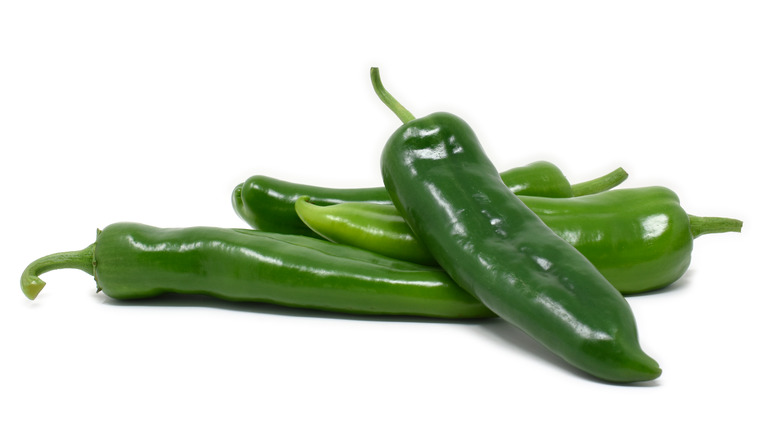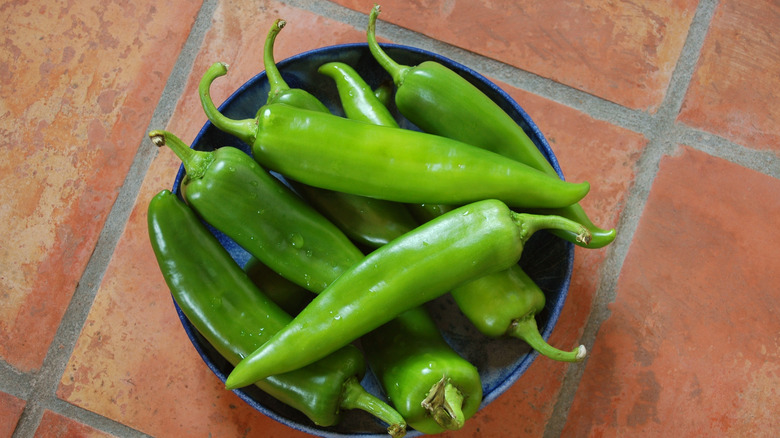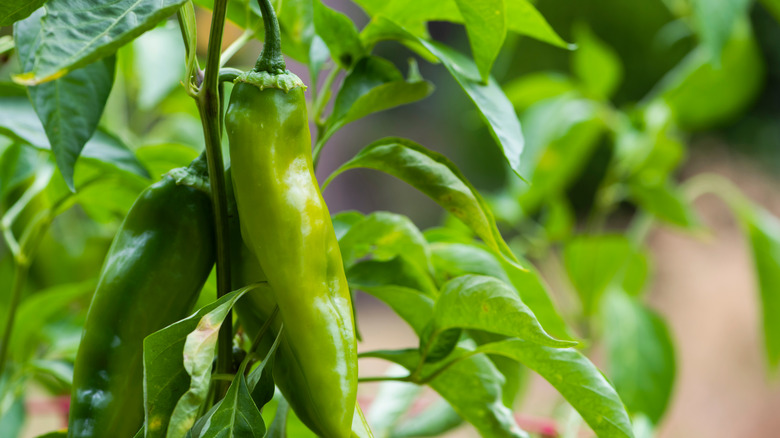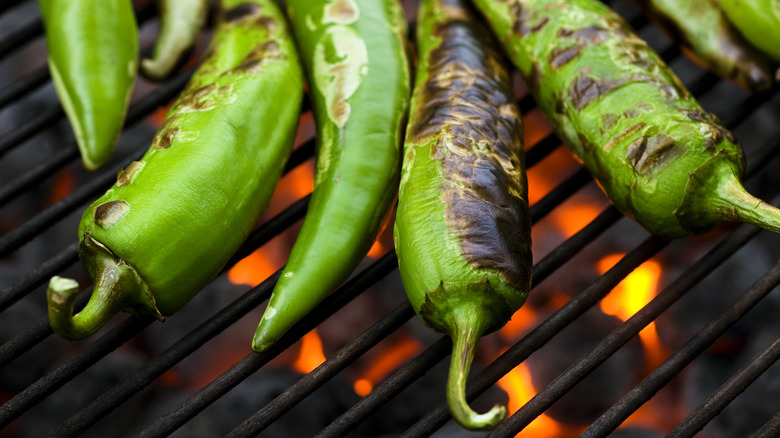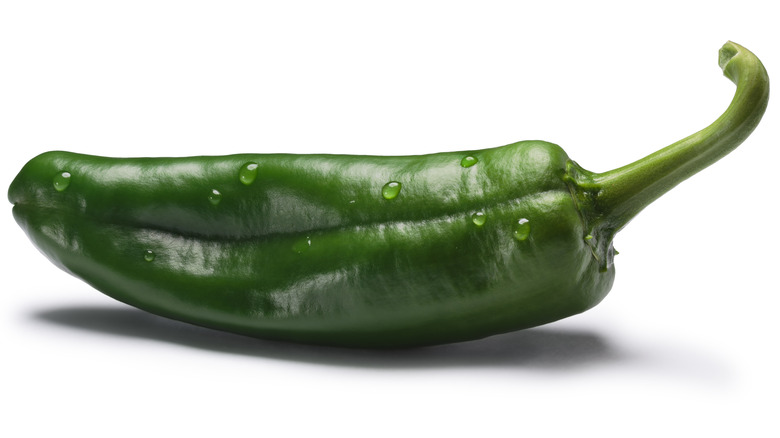Anaheim Peppers Are Perfect For Mild Palates
Peppers and Southwestern cooking are intertwined — dishes like chili, chile relleno, and chile con queso are hallmarks of the cuisine for a reason. And while serranos, jalapeños, and cayenne are popularly used in many dishes, the region's unsung hero is the Anaheim. It's the pepper contained in that ubiquitous grocery store can – perfect for a quick chop into guacamole or thrown onto a burger.
In their raw form, the chiles are long and green, ranging from 6 to 10 inches in length. Low on the Scoville scale, only 500-2,500 units, Anaheims are mild enough to enjoy without cooking but also hold up well to heat. Sweet like bell pepper but with a tinge of spice, diners may sometimes confuse them with poblanos — although the two peppers do differ. And, often overlooked by their more celebrated relative, the Hatch chile, Anaheims deserve some distinct recognition. Let's dive into what they're all about.
What are Anaheim peppers?
The name may make you recall a place in California, and such an association does have a reason. The peppers were first grown commercially around the Southern Californian city by businessman Emilio Ortega — his name interlinked to the popular brand of canned green chilies.
The varietal was brought from New Mexico, where it's still grown today as the Hatch chile. While the peppers share common genetic origins, they're now different plants. Anaheim chiles run sweeter than their New Mexican counterparts and have a less smokey, fiery flavor. Such differentiation is an application of terroir to peppers. Chiles from the Hatch valley run a unique set of characteristics, with soil, processing, and storage affecting the result. The same applies to Anaheim's, which showcases sweeter notes from Californian soil.
In addition to their more common green form, Anaheim's are sometimes left to ripen to a more red state. In this condition, they're called Chile Colorado or California peppers and used as a spice in chili powder blends.
Anaheim peppers' flavor and how to cook with them
As a pepper low on the Scoville scale, Anaheims share characteristics with bell peppers. The two have a similar sweetness and crispy texture, but Anaheims pack in just a smidge more spice. Additionally, some varieties can also have a tangy note — it depends on when they're picked. The matured pepper, which is the redder variant, has a spicier flavor. Make sure to adjust depending on which type is purchased.
In their raw form, Anaheims have a tantalizing crunch accompanied by a bit of fruitiness. They make for a great addition to salads. To accentuate their tanginess, some chefs pickle the pepper. Like their relative Hatch, Anaheim peppers also shine after roasting. The skin turns to a palatable char, and its sweetness is accentuated by smoke. Simply throw Anaheims onto a gas burner or grill, and then add to a burger, taco, or even pasta for a smokey component. While these are often used techniques, there are also some quintessential dishes prepared with these peppers — let's dive into the classics.
Dishes prepared with Anaheim peppers
To appreciate their delectable flavor, start by concocting a salsa. Especially for fans of milder salsa varieties, charred Anaheims add a sweet, smokey note that pairs especially well with tomatillos and lime. Well-equipped for use in liquid form, Anaheim peppers can also add a pleasant flavor and substance to soup. Consider adding to the base of chicken tortilla soup, chile verde, or a caldo de queso.
Due to the chile's large size and volume, they're a popular candidate for baked stuffed pepper dishes. Whether it's with ground beef, cheese, chorizo, or a combination, the Anaheim will hold up for a long bake time — no need to worry about a mushy result. Plus, their lack of spice allows for heat to be controlled with the filling's contents. Alternatively, go for a classic, and cook a battered and fried chile relleno; the pepper is perfect for the job.
Keep in mind Anaheims can be substituted in any application that calls for poblanos, jalapeños, and other green peppers. A less spicy alternative with a smoky flavor, it's the perfect substitution that'll appeal to milder palates.
Where to buy and store Anaheim peppers
Anaheim peppers are widely available at groceries, especially those stocked with Mexican or Southwestern items. There are a few vendors that sell the pepper online. Farmer's markets, especially in California, are also a great source of the pepper — and a way to guarantee it's fresh. Anaheim peppers taste best soon after harvest, and their taste deteriorates quickly if improperly stored. It's best to keep them without a bag in the produce section of the fridge. In this form, they will last for up to two weeks. Anaheims can also be frozen — just make sure to wash them before freezing. Directly from the freezer, they can be charred or tossed into a soup
Then there are also dried Anaheim peppers. This variety offers a more concentrated flavor palate than the raw version. They're a great substitute in soups and salsas. And as the sturdiest version of the pepper, they can store for over a year.
